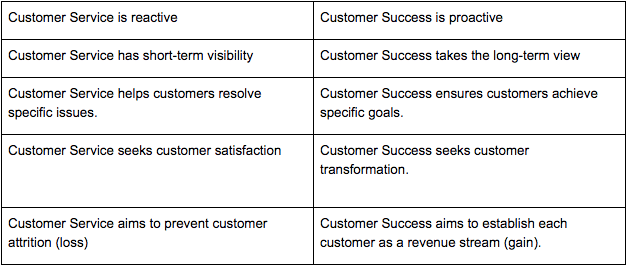The Difference Between Customer Success and Customer Support
We have all been there – waiting on a line to reach customer support.
Whether you needed to solve a problem with your banker, airline, or online purchase, your first step was to call customer support. This has been a predictable part of our customer experience.
However, in the SaaS community, customer support has evolved. Companies have transformed their customer support agents into customer success teams.
Not sure what the difference between customer support and customer success is? The rest of this article will dive into what customer success and customer support are and how they are different. From there, we’ll take a deeper look at what customer success is all about – and why it may be one of the most important things for your business.
What is Customer Support?
Customer support is the service a company provides clients with when they have questions or complaints about a product. When there is a ticket that needs to be resolved, team representatives are on it.
Customer support is continually utilized throughout the entire customer lifecycle – from planning and implementation to maintenance and upgrades. Once associated with call centers, customer support now spans many digital channels, including email, phone, instant messaging or SMS, and social media applications.
According to recent research, more than half of U.S. online shoppers use instant chat boxes when they need information from a company. Because of consumers’ increasing need for constant communication and feedback, more companies are integrating instant messaging with their support teams. Though this is a growing trend, calls and emails are still popular forms of communication between businesses and customers.
Customer support is on the frontlines of customer relationship management. The main goals of customer support teams are to solve individual customer’s issues, one at a time, and make sure products are working properly. While both these functions are essential to creating a healthy business with loyal customers, support teams have traditionally not been very involved in actively shaping a company’s business strategy.
Customer success teams, on the other hand, exert more influence over business strategy along with handling these essential tasks.
What is Customer Success?
When your customers succeed, you succeed.
Customer success is all about making sure customers achieve their goals. The main job of a customer success team is to make sure that clients get the most value out of the service or product your company offers.
B2B SaaS companies have put a large emphasis on their customer success strategies, and for many businesses, it has become the bread and butter of their business model. According to Jason Lemkin, Founder and Chief Investment Officer of SaaStr, “Customer success is where 90% of the revenue is.”
Customer success reduces customer churn and increases upsell and cross-sell opportunities.
Leaders in the SaaS industry, like Salesforce, adopted customer success because they recognized that a customer’s value was based on long-term commitment. Most SaaS companies have a subscription-based payment method. The pricing usually starts low, sometimes including a ‘freemium’ or free trial period, but increases with more advanced packages. With this business model, renewals are critical for gaining revenue. Profits lie in customer retention and losing customers means significant loss. The customer success team is there to provide guidance on what tools would best advance their client’s businesses, and ultimately help ensure more customers are retained.
Customer success is proactive. Teams build relationships with clients, understand their unique needs and goals, and consult them on how their product can best be used to meet those goals.
With today’s advanced technology, different tools can be shaped to mold to different business models. To ensure that the SaaS product is serving a customer at full capacity, the success team stays in constant communication with the client to support their goals.
Main Differences Between Customer Success and Customer Support

At their core, customer success and customer support teams have very different approaches of interacting with customers or clients. Here are the key differences:
Reactive vs Proactive
Customer support is reactive. A client contacts customer support when they need assistance with the product and the customer support team responds with guidance and resolution to this specific query. The customer support member stays in communication with the client until the specific issue is resolved, but then the conversation is ended.
On the other hand, customer success is proactive. Customer success starts with understanding the customer experience along the entire customer lifecycle. Data and customer insights help guide the strategy of the customer success team. Rather than reacting to individual customer’s problems as they surface, customer success teams keep in constant communication with clients and guide them towards their goals and prevent problems before they happen. Interruptions and customer issues do arise within a customer success-client relationship, but this is not the primary function of this department.
Short-term vs Long-term
The focus of the customer support team is on the short-term. A customer support team resolves issue by issue, dealing with immediate concerns as they emerge. Typically, they don’t use these issues to inform long-term business strategy.
Conversely, customer success teams are in it for the long haul and are more focused on longer-term goals. Customer support teams use objective data collection to inform product recommendations they make to clients. They engage in problem mitigation and assess where their opportunities lie. Customer support aims to set their customer up for success, thus increasing renewals and contributing to business growth. In this sense, customer success if about helping customers succeed, but also about crafting a better long-term business strategy for SaaS technology providers.
Negative vs Positive Outcomes
The success of a customer support team is generally dependent on overcoming a negative issue with the product. An individual contacts customer support when there is a problem or misunderstanding at hand. When a team member resolves the error and eases the customer’s frustration or confusion, they have accomplished their goal.
Customer success teams accomplish their goal when the team inspires a positive win for a client company. Unlike customer support teams, customer success teams actively try to prevent issues with the product or service from occurring. To do this, they reach out to customers well before problems arise and start to build a relationship. While communicating with customers, representatives act as consultants to achieve positive outcomes for the client.
A Deeper Look at Customer Success
While they both serve an important function, SaaS companies depend on customer success to drive their business.
Why Customer Success is Important
According to a report by Walker, user experience will be more important than product quality, or even price, by 2020. In an age where software is no longer plug and play, SaaS companies have had to up their support game in order to create better user experiences.
SaaS products are not just software, they are services too. When businesses invest in cloud-based solutions, such as a Customer Relationship Management (CRM) solution, Project Management tools, and All-in-One Marketing platforms, they often consider how good the support and service teams are.
The customer success representatives they communicate with will greatly impact how they use the product, what outcomes they face, and how much ROI they see.
Though it is difficult to calculate exact ROI of customer success teams, researchers from the Harvard Business Review stated,
“In our research and consulting on customer journeys, we’ve found that organizations able to skillfully manage the entire experience reap enormous rewards: enhanced customer satisfaction, reduced churn, increased revenue, and greater employee satisfaction.”
Companies that prioritize customer success have seen increased renewal rates. The more subscription renewals a SaaS earns, the more profit they gain.
Why are renewals so important? Gaining a new client doesn’t bring in much money, but keeping one does. The cost of acquiring a new customer is expensive. On average, it takes a SaaS company one year to regain the costs of acquiring a customer.
Most SaaS companies offer a minimal viable product (MVP) to introduce customers to the basics of their solution. They gradually improve their product and use upsells and cross-sells to promote user success. Customer success teams show clients their growth opportunities by displaying previous successes and tools that could potentially benefit them for a slightly higher cost.
Customer success managers also track their clients to see if churn is approaching with customer feedback and customer engagement strategies. Using this data, they can help craft business strategies to prevent customer churn.
How Customer Success Works
Customer success depends on three pieces: an organizational strategy, people who know what they are doing, and the right tools.
There is no beginning and no end to customer success. It is embedded across entire organizations and takes place across the entire customer lifecycle.
Customer success strategy starts with assessing where you currently are with customer relationships. This can look like a customer success map, an assessment on where you are on maturity model, or just answering some honest questions such as:
- What does our customer experience look like right now?
- How can we improve customer experience?
- How do our customers like to communicate?
- What can we do to strategically engage with our customers?
- When will we implement our new formed strategy?
Customer Success Teams: The People Who Pull it All Together
Customer success team roles are relatively new but are quickly becoming some of the most dynamic positions within SaaS organizations.
The customer success team doesn’t only interact with customers; they are the bridge between the customers and the development, marketing, and sales teams. They know the product and the people who use the product, and the data they collect informs all other processes of an organization.
After collecting data on customer feedback, the team can communicate with the product designers about the weaknesses, strengths, and opportunities for further development. They also communicate with marketers about types of leads they should be pursuing, and with sales teams to inform them about client needs and possible pitch ideas.
A customer success team can be made up of a variety of different professionals with diverse backgrounds. Key roles include the customer success manager, learning team associates, sales engineers, and tech professionals who understand the intricacies of a product.
Customer Success Solution: The Crucial SaaS for other SaaS Companies
Customer success activities cannot be performed properly without the right solutions. Like many SaaS solutions, this tool has two main components: software and support.
When looking for the right customer success software, professionals need to look for a solution that works with their CRM and can also connect with their product. This will allow the solution to track and store necessary customer and product data. Teams should also be able to add their own data collected from other customer interactions.
It wouldn’t be fitting for a customer success solution not to have a strong customer success team themselves. Each SaaS offering is unique and will take additional support to bring about the best outcomes for clients.
Here are some of the Top Rated Customer Success Solutions on the TrustRadius platform:
Whether you are a start-up getting off the ground or a company struggling with high churn rates, customer success is one of the best ways to drive your business. Before choosing a Customer Success solution, read customer reviews to get honest insights on which solutions will best fit your needs.
Was this helpful?
